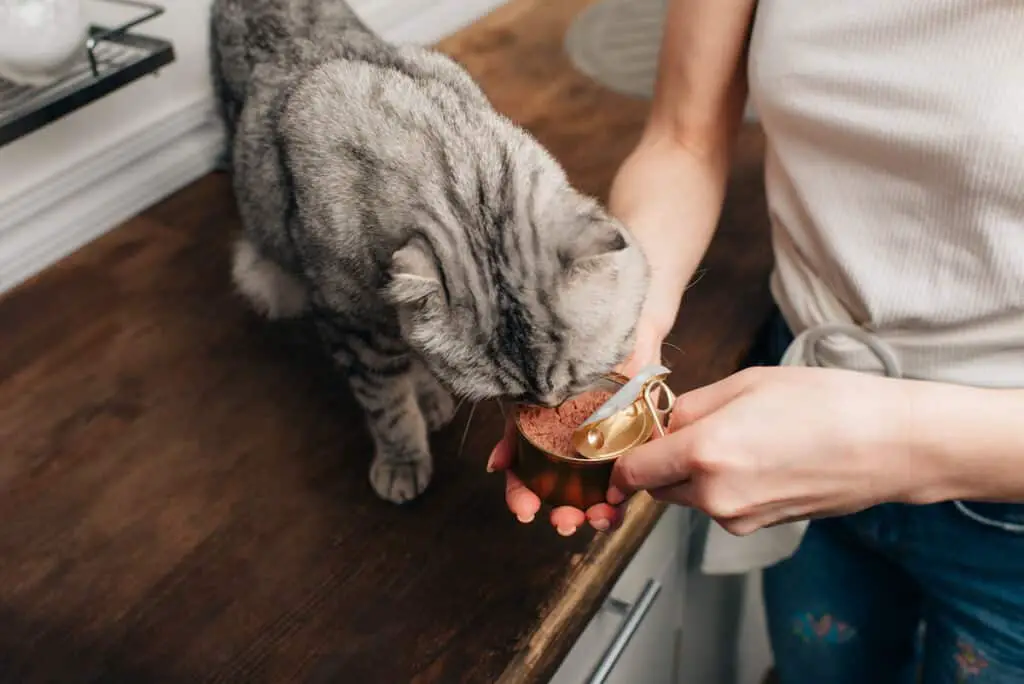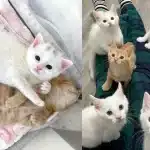Are you unsure about what to feed your new cat or considering changing its diet to better promote its general health and wellbeing? Choosing whether to feed them kibble or canned wet food is one of the first decisions you’ll need to make. The best answer will ultimately depend on the unique requirements and tastes of your pet, but we asked a few experts to weigh in on the merits (and cons) and recommend the top wet cat food brands currently on the market.
Table of Contents
- What to Know Before Buying Wet Cat Food
- The Best Wet Cat Foods for Indoor Cats
- 1. Best Overall: Iams Perfect Portions Indoor Adult Grain-Free Wet Cat Food
- 2. Great if your cats don’t like fish: Purina Fancy Feast Gravy Wet Cat Food
- 3. Best for Cats with Sensitive Systems: Hill’s Science Diet Adult Urinary Hairball Control Wet Cat Food
- 4. Great for Active Cats: Tiki Cat Aloha Friends Grain Free Wet Cat Food
- 5. Best for Weight Management: Hill’s Science Diet Perfect Weight Canned Wet Cat Food
- 6. Great for nursing cats and kittens: Royal Canin Feline Health Nutrition Mother & Babycat Canned Wet Cat Food
What to Know Before Buying Wet Cat Food
Age, breed, and general health can all have a large impact on which foods are ideal for your pet when it comes to planning out their diet, so you should always speak with a veterinarian before making any significant changes. While wet food is equally important because it can help cats stay hydrated and may be closer to the natural diet they’d have in the wild, most experts agree that kibble has its benefits, including being handy, inexpensive, and possibly being good for feline teeth.
According to Dr. John P. Loftus, Ph.D., DVM, an assistant professor at the Cornell College of Veterinary Medicine, “domestic cats are desert animals, therefore they naturally don’t drink much water.” Dr. Gary Richter, DVM, founder of Ultimate Pet Nutrition and author of The Ultimate Pet Health Guide: Breakthrough Nutrition and Integrative Care for Dogs and Cats, makes a similar point. He says that because cats “don’t naturally drink a lot of water,” “it is important for them to get a lot of water in their food.”
Drs. Loftus and Richter assert that canned wet food has a distinct advantage over kibble due to its higher moisture content; Dr. Richter even asserts that while dry food is frequently thought to be better for feline dental health, an all-kibble diet is not advised because cats are carnivores and “high carbohydrate diets such as dry food are not the best for them.”
Furthermore, the veterinarian and proprietor of Feline Health in New York City, Dr. Cori Blair, DVM, compares canned wet food high in protein to the salad as opposed to kibble, which she compares to the bread you could find at a restaurant: Even while the bread could be delicious, if you eat too much of it, you probably won’t have room for the remainder. Cats are the same way. Dr. Blair claims that canned food is better for cats’ kidneys and that it also helps them maintain greater hydration and leaner body mass.
Including canned wet food in your cat’s regular diet may also make it easier for them to handle certain medical concerns. Dr. Katy Nelson, a senior veterinarian at Chewy, tells Mental Floss that wet food’s higher protein and lower carbohydrate composition is beneficial for diabetic cats. The caloric and nutrient density of wet food can be excellent for kittens and nursing mothers, and the higher moisture content may benefit cats with urinary problems, adds Dr. Nelson. As cats metabolize protein much more efficiently than carbohydrates (which they tend to accumulate), which can also be tested simply to ensure your kitty is remaining under their daily calorie requirements, she continues, “wet food can also be good for cats on a weight-loss diet.
Having said that, there are a few considerations to make if you intend to give your cat a plate of pate any time soon. Wet food’s “shelf life” in the bowl is shorter than that of dry food, according to Dr. Nelson. After a couple of hours, she advises tossing any leftovers because they could all go bad. The stage of development at which your pet is in is a significant additional consideration. Dr. Loftus advises pet owners to take caution when selecting a canned food to make sure it is made to fulfill the nutritional needs of the cat’s life stage. He advises searching for the Association of American Feed Control Officials (AAFCO) statement, which ought to be on the can’s label, if you’re unsure.
Dr. Blair asserts that a diet consisting solely of canned food may cause constipation in certain cats, who may then require fiber supplementation to restore normal bowel function. As a result, pet owners may wish to think about feeding their pets a blended diet, which includes both kibble and canned wet food as well as fresh, whole foods. Dr. Richter continues, “People should look for quality foods with all-natural components if they are going to feed [cats] canned foods.” “No artificial preservatives, no grains.”
The Best Wet Cat Foods for Indoor Cats
1. Best Overall: Iams Perfect Portions Indoor Adult Grain-Free Wet Cat Food

It can be challenging to decide which canned wet food is the best overall choice because there are so many varieties available (and pet-specific considerations like age and health must be made). However, Dr. Nelson believes that this Iams variety pack is a fantastic option if you want to promote the general wellbeing of your indoor cat: It is soft, simple to chew, and free of artificial preservatives or grains. In order to provide your pet with a balanced diet without worrying that you could be giving them too much food, each easy-peel tray also comes in handy amounts.
2. Great if your cats don’t like fish: Purina Fancy Feast Gravy Wet Cat Food

Along with Iams, Hill’s Science Diet, and Royal Canin, Purina is one of the top brands that Dr. Blair suggests to readers of Mental Floss because “these businesses all undertake constant studies on their products to ensure they are high quality.” You might want to think about purchasing this 30-pack from Fancy Feast if your pet often favors chicken, turkey, and/or beef dinners over fishy ones.
3. Best for Cats with Sensitive Systems: Hill’s Science Diet Adult Urinary Hairball Control Wet Cat Food

Despite the fact that only 1% to 3% of cats with urinary tract disease may acquire urinary tract infections, prevention is the key to preserving your cat’s health because problems in that area might still arise. According to Dr. Nelson, this variety pack from Hill’s Science Diet could improve your cat’s overall wellness and provide additional magnesium to their diet if they have a sensitive system. Assuring your cat’s comfort and tranquility, she explains, “this functional food helps prevent the development of urinary system problems in cats and also contains natural fiber to decrease hairballs.”
4. Great for Active Cats: Tiki Cat Aloha Friends Grain Free Wet Cat Food

Tiki Cat Aloha Friends offers high-quality animal protein, which is essential for maintaining cats’ slim, active muscles. The grain-free variety packs, which include tuna, pumpkin, calamari and shrimp are some of the most well-liked varieties. In addition to critical vitamins, minerals, and taurine, the recipe also includes actual broth, which offers the required moisture levels to help keep cats hydrated.
5. Best for Weight Management: Hill’s Science Diet Perfect Weight Canned Wet Cat Food

This wet cat chow is prepared from ingredients that support a balanced diet, including chicken broth, hog liver, carrots, spinach, and more, claims the manufacturer. Additionally, it was created specifically with overweight cats in mind; in product testing, more than 70% of felines munching on these treats were said to have lost weight in less than 10 weeks. However, to be on the safe side, make sure to confirm with your vet before including this in your pet’s diet, particularly if your cat has any other underlying medical issues.
6. Great for nursing cats and kittens: Royal Canin Feline Health Nutrition Mother & Babycat Canned Wet Cat Food

Food prepared with their unique requirements in mind is necessary for both mother cats and young kittens. Docosahexaenoic acid (DHA), which is a naturally occurring omega-3 fatty acid that is present in breast milk and may help your kitten’s cognitive development, is included in this wet cat food, which is formulated with chicken and a combination of vitamins and other nutrients. Additionally, each can has a combination of prebiotics and highly digestible proteins that are gentle on their developing (and changing) systems. Additionally, the texture is a little softer than standard paté; Royal Canin likens it to fluffy mousse and states that it helps make the transition from milk to solid food easier for newborn kittens.














